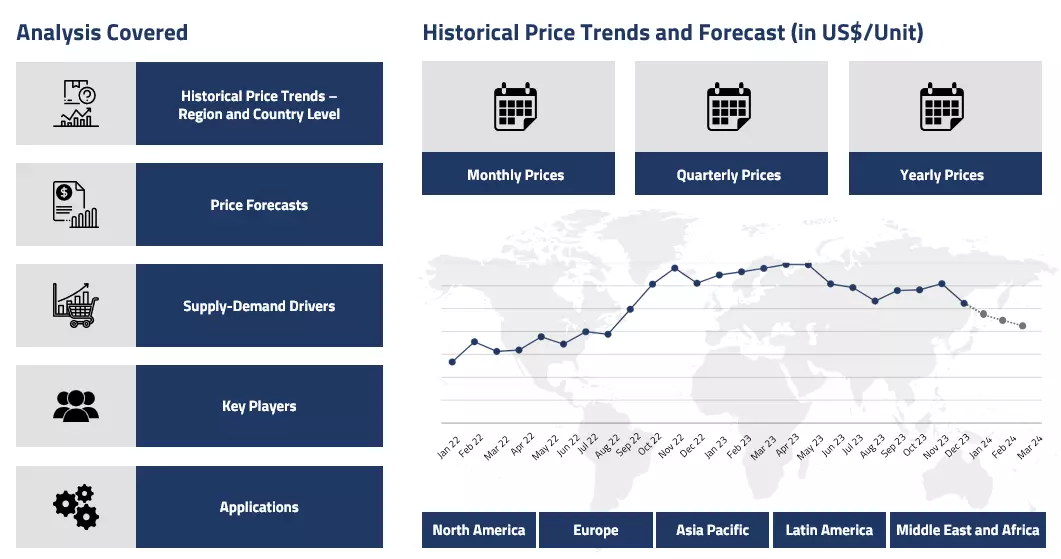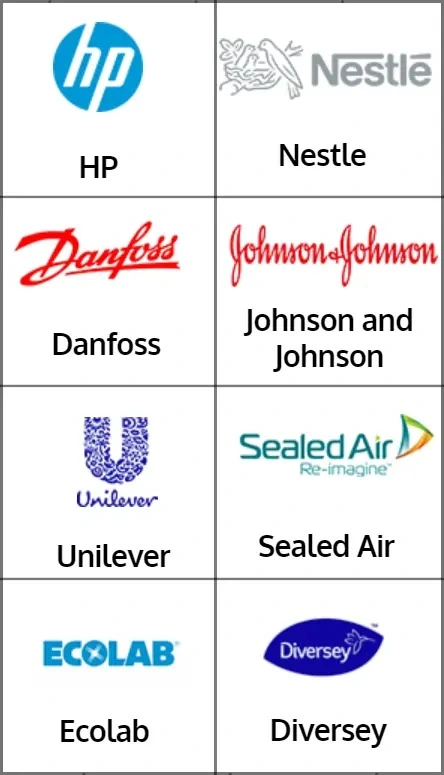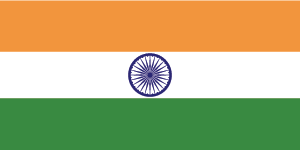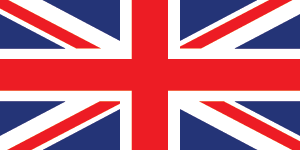Product
Viscose Spunlace Price Trend and Forecast
Viscose Spunlace Price Trend and Forecast
Viscose Spunlace Regional Price Overview
Get the latest insights on price movement and trend analysis of Viscose Spunlace in different regions across the world (Asia, Europe, North America, Latin America, and the Middle East & Africa).
Viscose Spunlace Price Trend for Q1 of 2025
Asia
In Q1’25, the Viscose Spunlace market in Asia experienced a mixed trend, similar to the broader viscose fibre market. January and early February saw steady demand from hygiene and nonwoven sectors, supported by active replenishment after the New Year holidays. Manufacturers resumed operations gradually, which helped avoid supply surpluses and kept prices stable to slightly firm. However, as February progressed, demand softened due to tight liquidity in downstream sectors and cautious purchasing behaviour.
Viscose Spunlace Price Chart

Please Login or Subscribe to Access the Viscose Spunlace Price Chart Data
The market saw a further slowdown in March, with increasing inventories and weaker orders from export markets. While feedstock availability remained stable and freight rates declined, sluggish textile and hygiene sector consumption weighed on prices. Overall, the quarter ended on a weaker note for the Asian Viscose Spunlace market.
Europe
The European Viscose Spunlace market showed a largely positive tone during the first two months of Q1’25. Strong post-holiday demand, especially from the hygiene and personal care industries, drove active restocking. Supply constraints due to ongoing port congestion and labor disruptions added upward pressure to prices during January and February.
However, March brought a mild correction as supply conditions improved and demand growth slowed. Buyers turned cautious amid softening global economic signals and concerns over excess inventory. Despite lingering logistical challenges and steady production costs, the market faced slight downward pressure toward the end of the quarter.
North America
In North America, the Viscose Spunlace market followed a bearish path throughout Q1’25. January began with optimism as buyers moved quickly to secure materials amid concerns of port strikes and rising freight costs. However, as the quarter advanced, market sentiment turned weaker.
Inventory levels remained high, imports continued steadily, and demand from nonwovens and hygiene sectors lost momentum. March saw reduced buyer activity, influenced by soft consumer spending and ongoing uncertainty around trade policies and tariffs. Lower freight rates and stable feedstock prices offered little support, and overall pricing softened through the quarter.
Analyst Insight
According to Procurement Resource, the Viscose Spunlace market may face continued pricing pressure if demand recovery remains slow, although any improvements in global trade flows could help stabilize sentiment.
Viscose Spunlace Price Trend for the Second Half of 2024
Asia
In the second half of 2024, the Viscose Spunlace market in Asia followed a mostly downward trend. During Q3, prices showed some improvement driven by tight VSF supply and slightly higher feedstock costs. However, this strength faded quickly in Q4 as oversupply issues and weak demand returned, especially from the textile and hygiene sectors.
Manufacturers struggled with high inventories and slower export activity. Even though there were some seasonal upticks in demand, they weren't strong enough to reverse the overall softness. China, being a major producer, saw declining prices due to destocking and limited orders from downstream buyers.
Europe
The European market for Viscose Spunlace remained under pressure in H2’24. In Q3, prices were relatively stable, helped by balanced supply and demand. However, the situation worsened in Q4, with demand weakening from both apparel and hygiene industries.
High inventory levels, weak consumer confidence, and logistical issues across the region all contributed to a decline in prices. Despite low raw material and energy costs, producers couldn’t lift prices due to muted market interest. Germany experienced some of the sharpest price corrections, reflecting broader regional difficulties.
North America
In North America, the Viscose Spunlace market showed mixed performance in H2’24. Q3 was more favorable, with steady demand from nonwovens and hygiene segments pushing prices slightly higher. Supply remained well-managed, and rising transport costs added some upward price pressure.
However, this trend did not hold in Q4. The market turned bearish due to weak apparel sector demand, rising imports of cheaper materials, and inflation-related consumer caution. By the end of the year, prices declined, and inventory levels remained high, limiting recovery.
Analyst Insight
According to Procurement Resource, the Viscose Spunlace market is likely to remain cautious, with any price recovery depending on improved global demand and tighter inventory control.
Viscose Spunlace Price Trend for the First Half of 2024
In the first half of 2024, the viscose spunlace market experienced steady yet subdued demand, largely influenced by the sluggish performance in downstream industries such as fashion and retail. While polyester and viscose yarn prices remained stable, demand for intermediary products like viscose spunlace faced similar slowdowns, particularly as the downstream industry did not see a significant revival. Traders in key markets noted that demand for viscose yarn, which is closely tied to viscose spunlace, showed some improvement earlier in the year but eventually eased off as retail and export demand weakened.
The geopolitical tensions and tight cash flows further constrained business activity, adding pressure to the market. In some parts of India, the conclusion of the wedding season, a key driver for polyester and viscose fabric demand, further dampened the market outlook for spunlace and related materials, with traders expecting a potential recovery only by mid-year. Similarly, the other markets observed a steady trend in viscose yarn prices as well, with demand remaining lackluster. Export demand was particularly weak, exacerbated by ongoing international tensions. However, in some other markets, despite increases in polyester staple fibre prices due to quality control orders on the polyester value chain, viscose-related products, including spunlace, continued to face poor demand from the downstream sectors.
The cotton market, which affects the pricing and demand dynamics of blended products like viscose spunlace, also saw easing prices due to declining arrivals and a lack of fresh buying from exporters and spinning mills. Overall, the viscose spunlace market in India mirrored the broader textile industry, with stable but weak demand in the first half of the year, influenced by low retail activity, geopolitical factors, and a generally slow-moving downstream sector. Traders expressed cautious optimism for a recovery later in the year, particularly as the wedding season and potential demand for blended fabrics could provide a much-needed boost.
Analyst Insight
According to procurement resources, the price of Viscose Spunlace is estimated to be guided by the changing outlook of downstream industries and varying trend of textile industries all over the world.
Viscose Spunlace Price Trend for the Second Half of 2023
Viscose Spunlace is a blended fabric made out of polyester and viscose. So, the prices vary according to the fluctuations in the prices of both these feedstock materials. The market began on a lower note at the beginning of the third quarter in July’23. The sullen demand patterns were primarily attributed to the lackluster demands from the importing countries. However, as the fourth quarter approached, the market dynamics started to change steadily.
The suppliers became cautious with procurement, and the production was also observed to have slowed down. So, the gap between the supply and demand outlooks started to dial down slowly and thus was able to provide a marginal forward push to the price trend. This continued till the middle of the fourth quarter, and then a further slip in the demand graph again pivoted the price graph in the reverse direction.
Analyst Insight
According to Procurement Resource, the Viscose Spunlace price trends are likely to experience fluctuations in the coming months as well. Downstream consumption will continue to dominate among the other market-driving factors.
Viscose Spunlace Price Trend for the First Half of 2023
Viscose spunlace is a viscose and polyester blend fibre. The price trend for Viscose Spunlace mostly rode high, especially in Asian markets like India, as the end consumer demands remained high. Further, the feedstock availability was curtailed for most of the said period, which provided a positive cost support by raising the upstream costs substantially.
On the other hand, in the Chinese market, the main demands for Viscose Spunlace come from personal care and wiping cloth industries. Even though the demands picked up rightfully in the COVID times when people have grown more cautious of cleanliness, the prices didn’t grow with the same force.
Primarily because suppliers not only ramped up production from existing Viscose Spunlace production plants, but many new production plants were set up with expectations of a rise in demand. This increased competition for prices and gave more options to traders. Overall, even with a fair presence of trade around Viscose Spunlace, prices had a stable run in the Chinese market in H1 2023.
Analyst insight
According to Procurement Resource, the Viscose Spunlace market is expected to continue fluctuating in the coming months since the market demands and feedstock prices continue to remain unsettled.
Procurement Resource provides latest prices of Viscose Spunlace. Each price database is tied to a user-friendly graphing tool dating back to 2014, which provides a range of functionalities: configuration of price series over user defined time period; comparison of product movements across countries; customisation of price currencies and unit; extraction of price data as excel files to be used offline.
About Viscose Spunlace
Viscose Spunlace is Spunlace nonwoven polyester and viscose fabric material comprising viscose and polyester fibre made using a hydroentangled bonding technology. It has great durability, liquid absorbent qualities, tough grime-clean capacity, and is food contact grade (SGS) proved.
Viscose Spunlace Product Details
| Report Features | Details |
| Product Name | Viscose Spunlace |
| Industrial Uses | Used to make products like dry hair towels, wet wipes, and facial wash towels in the healthcare and hygiene industry, to make special water–processed cloth. |
| Synonyms | Spunlace Viscose, Spun-lace Non-woven, Viscose Spunlace Fabric |
| HS Code | 56031200 |
| Supplier Database | Marusan Industry, Alpha Foam, Unitika, Mogul, Ginni Nonwovens, ANDRITZ, Novita SA, Birla Cellulose, Jacob Holm Group, Lentex, Guangzhou Junqian Nonwoven, Hangzhou Guozhen Industrial, Qingdao L&A Orient Nonwoven Manufacture, Hangzhou Nonwoven Supply (Hangzhou Source Nonwoven), Weston, Sheng Hung Industrial |
| Region/Countries Covered | Asia Pacific: China, India, Indonesia, Pakistan, Bangladesh, Japan, Philippines, Vietnam, Iran, Thailand, South Korea, Iraq, Saudi Arabia, Malaysia, Nepal, Taiwan, Sri Lanka, UAE, Israel, Hongkong, Singapore, Oman, Kuwait, Qatar, Australia, and New Zealand Europe: Germany, France, United Kingdom, Italy, Spain, Russia, Turkey, Netherlands, Poland, Sweden, Belgium, Austria, Ireland Switzerland, Norway, Denmark, Romania, Finland, Czech Republic, Portugal and Greece North America: United States and Canada Latin America: Brazil, Mexico, Argentina, Columbia, Chile, Ecuador, and Peru Africa: South Africa, Nigeria, Egypt, Algeria, Morocco |
| Currency | US$ (Data can also be provided in local currency) |
| Supplier Database Availability | Yes |
| Customization Scope | The report can be customized as per the requirements of the customer |
| Post-Sale Analyst Support | 360-degree analyst support after report delivery |
Note: Our supplier search experts can assist your procurement teams in compiling and validating a list of suppliers indicating they have products, services, and capabilities that meet your company's needs.
Viscose Spunlace Production Processes
Viscose spunlace production involves spinning viscose and polyester fibers and subjecting them to hydroentanglement using high-pressure water jets. This process enables the spinning and entangling of non-woven webs. After hydroentanglement, the non-woven material is dried and wound onto spools for further use.
Methodology
The displayed pricing data is derived through weighted average purchase price, including contract and spot transactions at the specified locations unless otherwise stated. The information provided comes from the compilation and processing of commercial data officially reported for each nation (i.e. government agencies, external trade bodies, and industry publications).
Assistance from Experts
Procurement Resource is a one-stop solution for businesses aiming at the best industry insights and market evaluation in the arena of procurement. Our team of market leaders covers all the facets of procurement strategies with its holistic industry reports, extensive production cost and pre-feasibility insights, and price trends dynamics impacting the cost trajectories of the plethora of products encompassing various industries. With the best analysis of the market trends and comprehensive consulting in light of the best strategic footstep, Procurement Resource got all that it takes.
Client's Satisfaction
Procurement Resource has made a mark for itself in terms of its rigorous assistance to its clientele. Our experienced panel of experts leave no stone unturned in ensuring the expertise at every step of our clients' strategic procurement journey. Our prompt assistance, prudential analysis, and pragmatic tactics considering the best procurement move for industries are all that sets us apart. We at Procurement Resource value our clients, which our clients vouch for.
Assured Quality
Expertise, judiciousness, and expedience are the crucial aspects of our modus operandi at Procurement Resource. Quality is non-negotiable, and we don't compromise on that. Our best-in-class solutions, elaborative consulting substantiated by exhaustive evaluation, and fool-proof reports have led us to come this far, making us the ‘numero uno' in the domain of procurement. Be it exclusive qualitative research or assiduous quantitative research methodologies, our high quality of work is what our clients swear by.
Table Of Contents
Our Clients

Get in Touch With Us

UNITED STATES
Phone:+1 307 363 1045

INDIA
Phone: +91 8850629517

UNITED KINGDOM
Phone: +44 7537 171117
Email: sales@procurementresource.com

